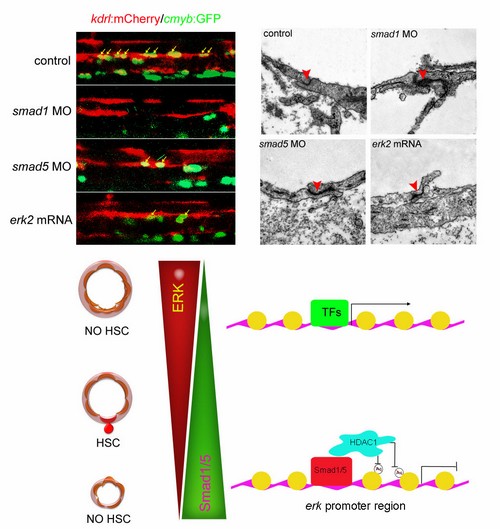Hematopoietic stem cells (HSCs) are a group of multipotent hematopoietic progenitor cells that can differentiate into all blood lineages to maintain normal life activities. Hematopoietic stem cell transplantation (HSCT) has become the most effective way to treat the malignant blood diseases, but it is still difficult to generate HSCs in vitro and maintain their pluripotency.
The Hematopoiesis and Cardiovascular Development Group led by Prof. Feng Liu, utilizing two model systems, zebrafish and mouse, identifies a novel regulatory mechanism between BMP and ERK signaling pathways during hematopoiesis. In zebrafish, inhibition of BMP signals or knockdown of its downstream factors smad1 leads to the increase of ERK1/2 expression, which indicates that BMP-Smad1/5 negatively regulates ERK1/2 at transcriptional level. ChIP assay shows that Smad1/5 recruits HDAC1 to the erk1/2 promoter region and leads to the decrease of acetylation level, and finally inhibits ERK1/2 expression. Further studies show that the over-activated ERK1/2 signals caused by the knockdown ofsmad1 or smad5 inhibit HSC emergence through promoting the arterial endothelial cell identity and enhancing the tight junction between endothelial cells. These results are confirmed in the mouse model, and reveal that the cross-talk between BMP and ERK pathways maintains a favorable condition required for the HSC emergence in vertebrates. This work provides new insights into the in vitro generation of transplantable HSCs for potential clinical applications. or smad5
This study was published online in Nature Communications (2014,5:3431) on Mar 11, 2014. This research was supported by grants from the National Basic Research Program of China (2010CB945302, 2011CB943904), the National Natural Science Foundation of China (31271570), and the Strategic Priority Research Program of the Chinese Academy of Sciences (XDA01010110).


